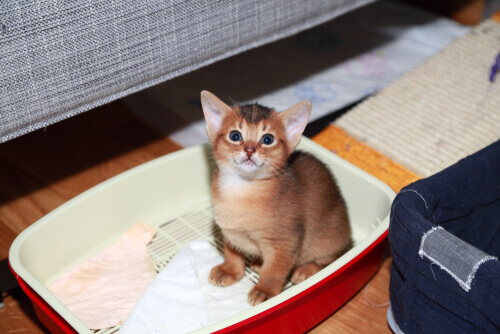Feline Education: Is it Really Possible to Train a Cat?

Cats are very independent animals. Their curious and fickle personality can test the patience of any first-time owner. As a result, these owners often think that it’s impossible or extremely difficult to train a cat. But fear not, as we’ll clear up any doubts you may have about this in this article.
Learning to recognize your cat’s moods
Cats communicate in a very different way than people do. Dogs, for example, will have no problem communicating what they want and how they want it. However, cats are much more reserved and proud creatures. Therefore, they need you to learn to recognize some of their mannerisms first.
Certain behavior our cat may display can give us a clue to understanding that something isn’t right with them. In addition, before trying to teach your cat anything, the most important thing is to make sure he or she is healthy and happy. Among the most alarming behaviors we know, we can find the following:
- Cats aren’t especially loving creatures, but they may feel especially uncomfortable or irritated by some kind of undiagnosed medical problem. If your pet is in a bad mood for a long time, shies away from human contact, or exhibits especially aggressive behavior, you may need to take him/her to the vet.
- A cat’s environment can affect them much more than we think. In addition, cats are creatures that love control and order, so a very drastic change, such as moving to a different home or remodeling, can cause them stress. As a result, you’ll notice that your pet will tend to exhibit self-destructive behavior or that it will tear up much of the furniture.

A happy cat is also easily recognizable. If the cat rubs itself against your legs, waves its tail and lifts it, and/or purrs in your presence, this is likely a sign that the bond you share is close and healthy.
Recommendations on how to train a cat
The different training tactics that exist today are specially designed to channel the energy and potential of our pets.
These tactics are based on positive stimuli and reinforcements aimed at making the animal as motivated as possible.

In a general sense, your cat needs to be able to associate a certain action with a command or a reaction coming from you. In order to do this, you can resort to the following tricks.
Tips on how to train a cat:
- Positive reinforcement. Rewards and gifts can be useful to teach your cat to behave in a certain way. You can reward them every time they choose to use their litter box. Also, every time they behave well with children or when they use their scratching post to sharpen their claws, instead of the sofa.
- To facilitate the learning process and avoid confusing the animal, try to use the same command or the same stimulus every time. However, it’s important to be consistent, otherwise your cat will never associate an action with a positive stimulus and will therefore ignore you.
- With early training, you can cause a better impression in your animal. As a result, your commands will be more imprinted in them and they’ll be more used to coexist with human beings in that way. Cats that are trained when they’re older tend to have certain habits and hobbies that are difficult to forget or replace.
- Negative reinforcement can be useful with stubborn or problematic cats. Especially those that systematically scratch your furniture and sometimes even your guests or friends. Remember that the goal is to educate, not to scare or hurt, so you should avoid using any kind of physical punishment (including shouting at them). Certain loud or strident sounds may be enough to get their attention and make them stop their unwanted behavior.
Clicker training
On the other hand, you can also clicker train your cat. A clicker is a small device that emits a ‘click’ every time your cat does what it’s told. This is a wonderful way to engage with your kitty and strengthen your bond with them. In addition, it can be a lot of fun!
Are you considering training your cat? Good luck!
Cats are very independent animals. Their curious and fickle personality can test the patience of any first-time owner. As a result, these owners often think that it’s impossible or extremely difficult to train a cat. But fear not, as we’ll clear up any doubts you may have about this in this article.
Learning to recognize your cat’s moods
Cats communicate in a very different way than people do. Dogs, for example, will have no problem communicating what they want and how they want it. However, cats are much more reserved and proud creatures. Therefore, they need you to learn to recognize some of their mannerisms first.
Certain behavior our cat may display can give us a clue to understanding that something isn’t right with them. In addition, before trying to teach your cat anything, the most important thing is to make sure he or she is healthy and happy. Among the most alarming behaviors we know, we can find the following:
- Cats aren’t especially loving creatures, but they may feel especially uncomfortable or irritated by some kind of undiagnosed medical problem. If your pet is in a bad mood for a long time, shies away from human contact, or exhibits especially aggressive behavior, you may need to take him/her to the vet.
- A cat’s environment can affect them much more than we think. In addition, cats are creatures that love control and order, so a very drastic change, such as moving to a different home or remodeling, can cause them stress. As a result, you’ll notice that your pet will tend to exhibit self-destructive behavior or that it will tear up much of the furniture.

A happy cat is also easily recognizable. If the cat rubs itself against your legs, waves its tail and lifts it, and/or purrs in your presence, this is likely a sign that the bond you share is close and healthy.
Recommendations on how to train a cat
The different training tactics that exist today are specially designed to channel the energy and potential of our pets.
These tactics are based on positive stimuli and reinforcements aimed at making the animal as motivated as possible.

In a general sense, your cat needs to be able to associate a certain action with a command or a reaction coming from you. In order to do this, you can resort to the following tricks.
Tips on how to train a cat:
- Positive reinforcement. Rewards and gifts can be useful to teach your cat to behave in a certain way. You can reward them every time they choose to use their litter box. Also, every time they behave well with children or when they use their scratching post to sharpen their claws, instead of the sofa.
- To facilitate the learning process and avoid confusing the animal, try to use the same command or the same stimulus every time. However, it’s important to be consistent, otherwise your cat will never associate an action with a positive stimulus and will therefore ignore you.
- With early training, you can cause a better impression in your animal. As a result, your commands will be more imprinted in them and they’ll be more used to coexist with human beings in that way. Cats that are trained when they’re older tend to have certain habits and hobbies that are difficult to forget or replace.
- Negative reinforcement can be useful with stubborn or problematic cats. Especially those that systematically scratch your furniture and sometimes even your guests or friends. Remember that the goal is to educate, not to scare or hurt, so you should avoid using any kind of physical punishment (including shouting at them). Certain loud or strident sounds may be enough to get their attention and make them stop their unwanted behavior.
Clicker training
On the other hand, you can also clicker train your cat. A clicker is a small device that emits a ‘click’ every time your cat does what it’s told. This is a wonderful way to engage with your kitty and strengthen your bond with them. In addition, it can be a lot of fun!
Are you considering training your cat? Good luck!
This text is provided for informational purposes only and does not replace consultation with a professional. If in doubt, consult your specialist.








